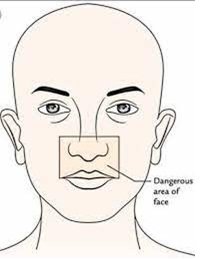The risks and hidden dangers of acne and all we need to know about Triangle of Death
 By, Dr Sunil Kumar Prabhu, Consultant, Dermatologist and Aesthetic Physician, Aster RV Hospital, Bengaluru
By, Dr Sunil Kumar Prabhu, Consultant, Dermatologist and Aesthetic Physician, Aster RV Hospital, Bengaluru
Acne is a common skin condition that affects millions of people worldwide. It occurs when hair follicles become clogged with oil and dead skin cells, leading to pimples, whiteheads, blackheads, and sometimes more severe forms like cysts. While acne is often considered a cosmetic concern, it can also have a significant impact on self-esteem and mental health. The “Triangle of Death” refers to a specific region of the face that includes the area between the nose and upper lip. This region is particularly sensitive due to its proximity to the cavernous sinus, a network of veins that drains blood from the brain. It’s essential to avoid touching or squeezing pimples in the Triangle of Death to minimize the risk of these complications. If you have severe acne or are concerned about the appearance of your skin, consult a dermatologist for professional advice and treatment.
What is the Triangle of Death?
The Triangle of Death refers to the area of the face that encompasses the bridge of the nose to the corners of the mouth, forming a triangle. This area is medically significant because it is densely populated with blood vessels that directly connect to the brain. The veins in this region do not have valves, meaning any infection here can easily spread to the brain, leading to severe complications such as cavernous sinus thrombosis, meningitis, or brain abscess.
Why is it Dangerous to Pop a Pimple in This Area?
Popping pimples is generally discouraged by dermatologists due to the risk of infection and scarring. However, doing so within the Triangle of Death carries additional, more severe risks. The blood vessels in this area drain into the cavernous sinus, a large vein at the base of the brain, and an infection here can spread to the brain, causing life-threatening conditions. Squeezing or popping a pimple can introduce bacteria from the skin’s surface into the bloodstream, potentially leading to serious infections such as meningitis or a brain abscess. One of the most severe risks is cavernous sinus thrombosis, a rare condition where a blood clot forms in the cavernous sinus, potentially causing stroke-like symptoms, vision loss, and other neurological complications, and it is often fatal if not treated promptly. Additionally, popping pimples can lead to permanent scarring and hyperpigmentation, particularly in sensitive areas like the face.
Causes of Pimples in the Triangle of Death
Pimples, also known as acne, can occur due to several factors, including hormonal fluctuations, bacterial infection, excess sebum production, and diet and lifestyle. Hormonal changes during puberty, menstruation, pregnancy, or conditions like polycystic ovary syndrome (PCOS) can increase oil production in the skin, leading to clogged pores and pimples. The bacterium Propionibacterium acnes (P. acnes) is commonly associated with acne, and when pores are clogged, this bacterium can multiply and cause inflammation. Overactive sebaceous glands can produce too much oil, clogging pores and creating an environment conducive to acne. Additionally, diets high in refined sugars and dairy products, stress, lack of sleep, and poor skincare habits can all contribute to the development of acne.
Treatment Options
Treating pimples within the Triangle of Death requires caution. Recommended approaches include using topical treatments with benzoyl peroxide, salicylic acid, or retinoids to reduce acne by killing bacteria, drying excess oil, and promoting cell turnover. For severe cases, a dermatologist may prescribe oral antibiotics, hormonal treatments like birth control pills, or isotretinoin (Accutane). Professional extraction by a dermatologist is advisable for pimple removal, as they use sterile techniques to minimize the risk of infection and scarring. Maintaining a regular skincare routine with gentle cleansing, moisturizing, and non-comedogenic products can help prevent acne. Additionally, identifying and avoiding triggers such as certain foods, stress, and poor hygiene practices can also help manage acne.
